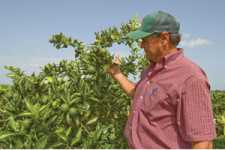Hope On 27

However, according to Steve Farr, citrus production manger for the company, Ben Hill Griffin Inc. is not holding back and believes in the future. While the company is diversified, it always has had a strong foundation in citrus. With that in mind, in 2007, they began replanting 2,000 acres of groves lost to disease.
One such planting is a 200-acre grove at the intersection of U.S. 27 and Florida 17. From day one, the young grove on its picturesque rolling landscape has caught the attention of passersby. Just the image itself of a large planting of a new grove embodies belief in the future of Florida citrus.
“Canker got the original planting in 2005,” says Farr. “It was a 40-year-old red grapefruit grove that was among the original blocks of Ben Hill Griffin Inc. We had considered some other options, but this company has been in citrus for more than 50 years.
“We believe, with today’s technology and the research that is being applied to find better tools to manage greening, we’ll make it.”
According to Ben Bolusky, executive vice president of the Florida Nursery, Growers & Landscape Association, the willingness to plant new trees varies by grower and the areas they are located in. “For those growers who see their glasses as half-full, they’re putting in some new trees or new blocks,” he says. “For those whose glasses are half-empty, they seem to be holding tight.
“In part, this appears to be dependent on one’s location. If one is located in an area where there are good results from coordinated psyllid sprays, they’re doing more resets. Growers in other areas where control is less aggressive, the planting is spottier. From what I’m hearing, propagations have held relatively steady over the last few years at three to four million trees, and they will probably stay about the same this year.”
Grove’s Got Giddy Up
Ironically, Farr attributes the grove’s growth to greening. In an effort to keep the disease at bay, he has applied an aggressive psyllid-control program, and in all of those sprays, foliar nutritional products are added. These include Ben Hill Griffin Inc.’s own line of foliar fertilizer products.
Traditional Setting
Disease Persists
Belief In The Future
Fighting Psyllids, Feeding Trees










